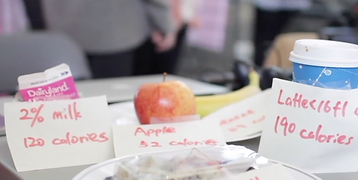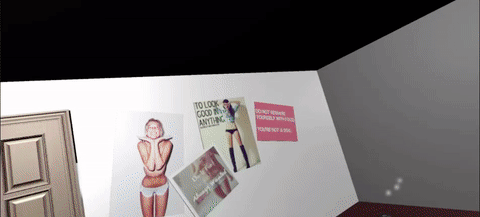Project Description
151 Calories is a immersive virtual reality project where people can experience the psychology state and the daily struggles of people with eating disorders. We particularly focus not only on the consumption of food but on the social and psychological consequences that correlate with eating disorders such as isolation from family/friends and constant self hate.
Team:
Roles:
Team Leader, Programmer,
Graphic Designer, Writer
Languages:
Javascript, C#
Tools:
The
Challenge
Within a timeframe of four weeks, our goal is to create an immersive experience that generates empathy and will help create an emotional bond between the audience and an experience that cannot be experienced normally using virtual reality as a medium.
With eating disorders as our topic, our main obstacle is to prevent being cliche and being overdone by bringing in lesser known aspects of anorexia such as social/psychological consequences to our audience. Along with any technical obstacles, we aim to try to prevent any frictions between people who have experienced eating orders who may encounter our virtual experience.
Our
Insights
As an all ladies teams, we wanted bring the audience to be aware of females encounters or experiences such as menstruation, catcalling or dieting. Our insight appeared when a friend on a diet said, 'Why can’t anorexic people just eat more? It's harder to diet than to eat.' while watching a video on eating disorders.
After a thorough discussion, we discovered that although most of us know about eating disorders, many of us don't understand what it's like to have an eating disordering or find it hard to sympathize those people which can lead to ignorance on the topic. Hence we decided to create a project for people to understand eating disorders. We also find the first person perspective that virtual reality being a great medium for this topic.


Participant trying our VR experience
Calories Counter Experience Display
The
Problem
Since none of our teammates were diagnosed with anorexia, we had to do in-
depth research by gaining insights from watching documentaries, both pro-anorexic and anti-anorexic awareness forums or blogs where people who have anorexia share their experiences first hand.


Forum where people with
Anorexia gather
Pro Anorexia Lifestyle Sites
My
Role
My role as the leader was to ensure the visual design, language and quality of the project is consistent and the topic is being portrayed accurately with little frictions. I also designed our posters plus printables, wrote the narrative script while helping my teammates create scenarios for our immersive experience based on our research. As a programmer, my tasks included creating interactable AIs with animated responses, interactable assets (ie. mirror, camera effects) and raycasting with a virtual body using the head mounted display gear.


Since body image is our theme, ability to see a virtual body was important
Friend AI waiting for your reply
For the interactable AI, I implicated waypoints, pathfinding and transitional animations for the AI. In order for for the audience to gain emotional bond with the 'Best Friend' AI, I had to make sure the AI’s expressions or hand movements transition smooth and timing properly with the dialogue to have the AI appear less static and real. I used Maximo's Animation Library to aid me to have quality expressions for our AI.


Project Description
151 Calories is an immersive virtual reality project. Users are able to experience the psychological state and daily struggles of those with eating disorders. We not only focused on food consumption but also the social and psychological consequences that correlate with eating disorders, such as, isolation from family/friends and constant self hate.
Team:
Roles:
Team Leader, Programmer,
Graphic Designer, Writer
Languages:
Javascript, C#
Tools:
The
Challenge
With a timeframe of four weeks, our goal was to create an immersive experience that generates empathy using virtual reality as a medium. We wanted to create a strong emotional bond between the audience and have them experience something they normally could not by normal means.
With eating disorders as our topic, our main obstacle is to prevent the experience from being cliche and overdone, by bringing in lesser known aspects of anorexia such as social/psychological consequences to our audience. We aim to prevent any possible frictions between people who have experienced eating orders if they were to encounter our project.
Our
Insights
As an all ladies teams, we wanted the audience to gain more awareness of female issues such as catcalling, menstruation or dieting. Our insight appeared when a friend on a diet said, 'Why can’t anorexic people just eat more? It's harder to diet than to eat.' while watching a video on eating disorders.
After watching a facebook video and a discussion, we discovered that most of us know that eating disorders exist but don't understand or see the issues regarding to eating disordering. It can become hard to sympathize with those people due to a lack of understanding which can lead to ignorance. Hence we decided to create a project for people to understand better about eating disorders. We also find the first person perspective that virtual reality being a great medium for this topic.


Participant trying our VR experience
Calories Counter Experience Display
The
Problem
As none of our teammates were diagnosed with anorexia, we had to do in-
depth research by gaining insights from watching documentaries, both pro-anorexic and anti-anorexic awareness forums or blogs. Which were places where people with eating disorders share their experiences first hand.


Forum where people with
Anorexia gather
Pro Anorexia Lifestyle Sites
My
Role
My role as the leader was to ensure the visual design, language and quality of the project is consistent and the topic is being portrayed accurately with little frictions. I also designed our posters plus printables, wrote the narrative script while helping my teammates create scenarios for our immersive experience based on our research. As a programmer, my tasks included creating interactable AIs with animated responses, interactable assets (ie. mirror, camera effects) and raycasting with a virtual body using the head mounted display gear.


Since body image is our theme, ability to see a virtual body was important
Friend AI waiting for your reply
For the interactable AI, I implicated waypoints, pathfinding and transitional animations for the AI. In order for for the audience to gain emotional bond with the 'Best Friend' AI, I had to make sure the AI’s expressions or hand movements transition smooth and timing properly with the dialogue to have the AI appear less static and real. I used Maximo's Animation Library to aid me to have quality expressions for our AI.


Handles automatic movement of the AI
The responses of the AI

Final Poster
The
Result
Due to technology issues and the lack of manpower, only around two scenarios were completed in our final product. Despite, I was happy to hear that our completed scenarios were very immersive. For example, interactions like the arms moving up when the audience looked up while they were doing the exercise activity. Most were interested in talking and interacting with the AI friend since they were able to talk and move around.
Since our experience was very narrative focused, an unfortunate issue was our story did not have an ending because of the missing scenarios. Some refinements and adjustments such as making the animations smoother or the weights less close to the camera for the exercising activity. would be good for the future.

